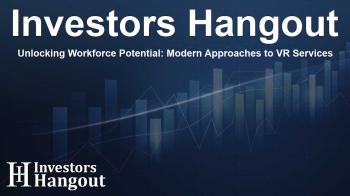Unlocking Workforce Potential: Modern Approaches to VR Services

Unlocking Workforce Potential: Modern Approaches to VR Services
Millions of skilled individuals with disabilities are ready to contribute to the economy, yet they often face significant barriers due to outdated vocational rehabilitation (VR) systems. This article highlights a compelling analysis that sheds light on how modernizing VR can open up a staggering $645 billion workforce opportunity.
According to the insights provided by Daivergent, a pioneer in AI-driven vocational rehabilitation, and the WGU Labs, the educational innovation arm of Western Governors University, today's VR professionals are stymied by complex bureaucracies and limited resources. Byran Dai, co-founder and CEO of Daivergent, points out that while these professionals possess a clear understanding of their clients' needs, their effectiveness is hampered by inadequate tools that are not aligned with the demands of a modern workforce.
The Historical Context of Vocational Rehabilitation
The journey of vocational support for individuals with disabilities began with the Individuals with Disabilities Education Act (IDEA), which opened educational pathways. This was further expanded by the Workforce Innovation and Opportunity Act (WIOA), aiming to integrate these individuals into the workforce. However, the harsh reality remains: as of recent statistics, only 37.8% of working-age individuals with disabilities are employed—significantly lower than the 77.3% employment rate of their non-disabled peers. This statistic leaves over 10.7 million talented individuals in limbo, all while industries nationwide seek skilled workers.
Overcoming Barriers in Vocational Rehabilitation
Dr. Betheny Gross, research director at WGU Labs, emphasizes the frustrations faced by skilled individuals with disabilities during their job search. She notes, "Despite the efforts of VR programs to bridge the gap between education and employment, many barriers continue to obstruct the path for these individuals, making it essential to innovate how these services operate." The modernization of VR through technology, aimed at leveraging existing solutions, can dramatically improve access and outcomes.
VR programs currently assist over a million job seekers each year, yet many are hindered by inefficiencies such as staffing shortages and outdated job-matching systems. Innovations in investing state resources in modernized VR approaches have shown promising results. For instance, in Maine, for every dollar spent on VR services, a return of $2.90 is realized within just a few years.
Harnessing Technology for Better Outcomes
Importantly, modernizing VR doesn't mean reallocating massive financial resources. In fact, many existing technologies could enhance employment outcomes significantly with minimal additional investment:
New Digital Solutions Revolutionizing VR
- Remote Career Coaching: This service eliminates geographical boundaries, allowing widespread access to populations often underserved.
- AI-Powered Job-Matching Platforms: These innovative tools connect skilled workers to employers actively seeking to fill crucial roles, particularly in growing sectors.
- Digital Credentialing and Skills Assessment: These tools expedite the integration of job seekers into suitable career paths based on their unique skills and qualifications.
WGU Labs and Daivergent assert that the economic benefits of investing in VR modernization are substantial. The VR services market is on track to rise from approximately $5.15 billion in 2023 to about $6.73 billion by 2028, fueled by advancements in remote work and intelligent workforce technologies.
The Economic Argument for Modernizing VR
A mere 1% increase in employment among individuals with disabilities could inject an additional $25 billion annually into the U.S. economy. Moreover, companies embracing inclusive hiring practices reportedly see revenue increases of 28% and profit margins that are 30% higher than those of their counterparts.
As the population of individuals with disabilities continues to grow, the urgency to strengthen VR systems becomes increasingly evident. This analysis aims not only at illuminating the necessity of modernizing vocational rehabilitation but also at providing actionable strategies for policymakers, businesses, and investors. It insists that with the right innovation, the doors can be opened wide for millions of deserving individuals, ensuring they are given equal opportunities to contribute to the workforce.
Frequently Asked Questions
What is the main opportunity identified in the analysis?
The analysis identifies a $645 billion workforce opportunity by modernizing vocational rehabilitation services for individuals with disabilities.
How can technology improve vocational rehabilitation?
Technology can enhance VR by providing remote coaching, AI job-matching platforms, and digital credentialing, improving access to employment opportunities.
What percentage of working-age individuals with disabilities are employed?
Currently, only 37.8% of working-age individuals with disabilities have jobs, compared to 77.3% of their non-disabled peers.
How can investing in VR benefit the economy?
Investing in VR can increase employment among individuals with disabilities, leading to a potential annual boost of $25 billion in the U.S. economy.
Why is modernizing vocational rehabilitation urgent?
Modernizing VR is urgent due to the increasing number of individuals with disabilities and the greater need for effective employment solutions in a rapidly changing workforce landscape.
About The Author
Contact Lucas Young privately here. Or send an email with ATTN: Lucas Young as the subject to contact@investorshangout.com.
About Investors Hangout
Investors Hangout is a leading online stock forum for financial discussion and learning, offering a wide range of free tools and resources. It draws in traders of all levels, who exchange market knowledge, investigate trading tactics, and keep an eye on industry developments in real time. Featuring financial articles, stock message boards, quotes, charts, company profiles, and live news updates. Through cooperative learning and a wealth of informational resources, it helps users from novices creating their first portfolios to experts honing their techniques. Join Investors Hangout today: https://investorshangout.com/
The content of this article is based on factual, publicly available information and does not represent legal, financial, or investment advice. Investors Hangout does not offer financial advice, and the author is not a licensed financial advisor. Consult a qualified advisor before making any financial or investment decisions based on this article. This article should not be considered advice to purchase, sell, or hold any securities or other investments. If any of the material provided here is inaccurate, please contact us for corrections.

